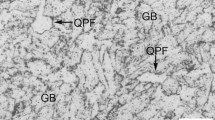Abstract
In this investigation, thermal simulated specimens were used to investigate the effect of second peak temperature during in-service welding on characteristic fracture energy and microstructure feature of the subcritically (SC), intercritically (IC), supercritically (SCR), and unaltered (UA) reheated coarse grain heat-affected zones (CGHAZs). The API X70 high-strength pipeline micro-alloyed steel was subjected to processing during in-service welding by applying double thermal cycle shielded metal arc welding process with heat input of 9.3 kJ/cm and thermal cycles to simulate microstructure of reheated CGHAZs. This consisted of first thermal cycle with a peak temperature of 1350 °C, then reheating to different second peak temperatures of 600, 800, 1000, and 1200 °C with a constant cooling rate of 60 °C/s. Toughness of the simulated reheated CGHAZs were assessed using Charpy impact testing at −20 °C, and the corresponding fractographs, optical micrographs, and electron micrographs have been examined. It is found that accelerating cooling rate during in-service welding has an improving effect on the microstructure of CGHAZs. Owing to small heat-input and accelerating cooling, the grain size in reheated CGHAZs is relatively small and the brittle microphases are eliminated or minimized. The Charpy impact results show that the CGHAZ fracture energy is improved after the second thermal cycle. The SC CGHAZ showed higher absorbed impact energy and the IR CGHAZ had less absorbed energy, but the phenomenon of embrittlement in IR CGHAZ is not serious. Therefore, it can be concluded that the fracture energy of CGHAZ and IR CGHAZ can be improved by accelerating cooling with appropriate cooling rate.









Similar content being viewed by others
References
Shin SY, Hwang B, Lee S, Kim NJ, Ahn SS (2007) Mater Sci Eng A 458(1–2):281. doi:10.1016/j.msea.2006.12.097
Corbett K, Bowen R, Petersen C (2004) Int J Offshore Polar Eng 14(1):105
Koo JY, Luton MJ, Bangaru NV, Petkovic RA, Fairchild DP, Petersen CW, Asahi H, Hara T, Terada Y, Sugiyama M, Tamehiro H, Komizo Y, Okaguchi S, Hamada M, Yamamoto A, Takeuchi I (2004) Int J Offshore Polar Eng 14(1):10
Xiao F-R, Liao B, Shan Y-Y, Qiao G-Y, Zhong Y, Zhang C, Yang K (2006) Mater Sci Eng A 431(1–2):41. doi:10.1016/j.msea.2006.05.029
Lee CH, Bhadeshia HKD H, Lee HC (2003) Mater Sci Eng A 360(1–2):249. doi:10.1016/s0921-5093(03)00477-5
Pan T, Yang ZG, Zhang C, Bai BZ, Fang HS (2006) Mater Sci Eng A 438–440:1128. doi:10.1016/j.msea.2006.02.078
Ju J-B, Lee J-S, Jang J-i (2007) Mater Lett 61(29):5178. doi:10.1016/j.matlet.2007.04.007
Zhou Z, Liu S (1998) Acta Metall Sin-Engl Lett 11(2):87
Lee S, Kim B, Kwon D (1992) Metall Mater Trans A 23(10):2803. doi:10.1007/bf02651759
Li Y, Crowther D, Green M, Mitchell P, Baker T (2001) Isij Int 41(1):46
Bayraktar E, Kaplan D (2004) J Mater Process Tech 153–154:87. doi:10.1016/j.jmatprotec.2004.04.021
Jang J-i, Ju J-B, Lee B-W, Kwon D, Kim W-S (2003) Mater Sci Eng A 340(1–2):68. doi:10.1016/s0921-5093(02)00190-9
Suzuki S, Kamo T, Komizo Y (2009) Weld Int 23(6):397
Yang Z, Sista S, Elmer JW, DebRoy T (2000) Acta Mater 48(20):4813. doi:10.1016/s1359-6454(00)00279-2
Sun W, Wang G, Zhang J, Xia D, Sun H (2009) J Mater Sci Technol 25(06):857
Qiu H, Mori H, Enoki M, Kishi T (2000) Metall Mater Trans A 31(11):2785
Andrews KW (1965) J Iron Steel Inst 203:721
John P (2002) In: Leigh F (ed) X80 pipeline cost workshop, Hobart
Acknowledgements
The research was partially supported by the National Natural Science Foundation of China (51074174) and the Innovation Fund for Doctors of China University of Petroleum (B2009-13).
Author information
Authors and Affiliations
Corresponding author
Rights and permissions
About this article
Cite this article
Li, C., Wang, Y. & Chen, Y. Influence of peak temperature during in-service welding of API X70 pipeline steels on microstructure and fracture energy of the reheated coarse grain heat-affected zones. J Mater Sci 46, 6424–6431 (2011). https://doi.org/10.1007/s10853-011-5592-7
Received:
Accepted:
Published:
Issue Date:
DOI: https://doi.org/10.1007/s10853-011-5592-7




